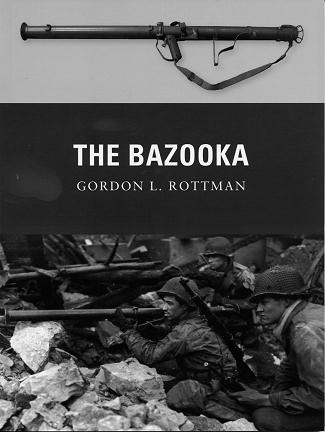 Number
18
in their 'Weapons' book series, Osprey has chosen the Bazooka. I doubt if there
are many enthusiasts who do not know about this weapon, as it really was an
excellent anti-tank weapon that had a variety of additional uses beyond its
initial design.
Number
18
in their 'Weapons' book series, Osprey has chosen the Bazooka. I doubt if there
are many enthusiasts who do not know about this weapon, as it really was an
excellent anti-tank weapon that had a variety of additional uses beyond its
initial design.
The US went to war without a really effective portable anti-tank weapon. The
37mm anti-tank gun was quite ineffective and other than mines or being hit by
artillery, there was not all that much that could be done to stop enemy tanks.
This was realized in 1941, as America went to war, that something had to be done
so suggestions went out to anyone who had an idea to bring it to the attention
of the Army.
Lt.Col. Leslie Skinner is considered the father of the
bazooka. His interest was in rocketry and he surmised that a rocket with a
warhead might be just the thing. Anti-tank rifles, while relatively portable had
little stopping power against anything besides very lightly armored vehicles and
the artillery was not easy to move around. He developed a shaped charge
warhead attached to an instant burning rocket that was to be electrically fired
from about a 5-6 foot tube. The rocket had to have expended all its fuel before
reaching the end of the tube to keep from injuring the operator. The back blast
was tremendous and would cause damage to anything directly behind it, but, being
in an open tube, it had no recoil.
The initial trial of the prototype before Army big-wigs
was impressive to say the least and more successful than any of the other
options tried during that time. It was decided to develop the weapon after
certain modifications were made. The bazooka of the time was 2.36 inches in
diameter and accurate to about 250-300 yards. It was capable of penetrating the
armor of most German tanks of the time if fired from relatively short range. It
was light and easily transported in combat. The down side was the back blast and
that it gave away the firing position the first time it was used.
Post war it was enlarged to 3.5 inches and the weapon
was continually modified as a result of battle experience. The British were give
the first batch to use in North Africa and snubbed the weapon, leaving the 500
they were provided in a warehouse in Egypt. Eventually it was used for defensive
positions, bunker busting and a variety of other uses.
Author Gordon Rottman tells us the story of the
bazooka from its inception, through various modification, trials and
tribulations, as well as unit uses until it was finally replaced by wire guided
weapons. Like
all books in this series, it is accompanied by period and modern photos of the different
variations and of those who carried the gun into combat. I am pleased to notice
that not much space has been taken on 'how to fire and maintain' the weapon as I
have seen in other books in this series. To me, this is of minimal interest
and should be treated as a footnote rather than a full section.
It all makes for another fine book and if you are
interested in weapons, then this book would make a fine addition to your
library.
July 2012
For more on the complete line of Osprey books,
visit www.ospreypublishing.com
or contact them at Osprey Direct, PO Box 140, Wellingborough, Northants,
NN8 2FA, UK. In the US, it is
Osprey Direct at 44-02 23rd St, Suite 219, Long Island City, NY 11101., where you can
get a catalogue of available books.
If you would like your product reviewed fairly and quickly, please
contact
me or see other details in the Note to
Contributors.
 Number
18
in their 'Weapons' book series, Osprey has chosen the Bazooka. I doubt if there
are many enthusiasts who do not know about this weapon, as it really was an
excellent anti-tank weapon that had a variety of additional uses beyond its
initial design.
Number
18
in their 'Weapons' book series, Osprey has chosen the Bazooka. I doubt if there
are many enthusiasts who do not know about this weapon, as it really was an
excellent anti-tank weapon that had a variety of additional uses beyond its
initial design.